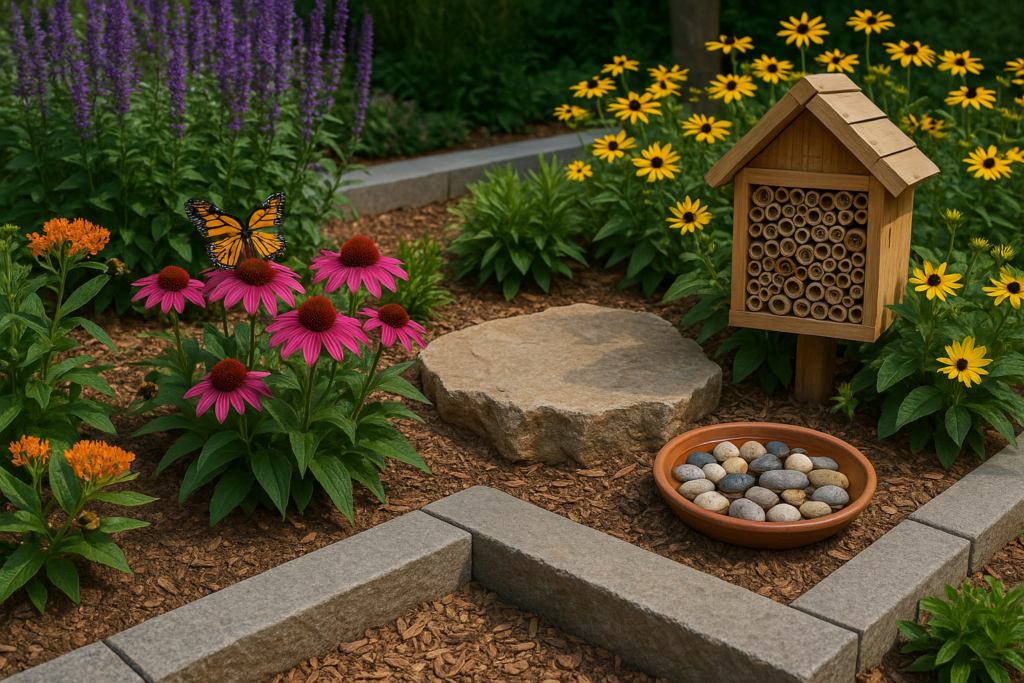In today’s rapidly changing climate, Bright View Landscape strategies are evolving to support not just aesthetic beauty but also ecological resilience. One of the most impactful ways to enhance biodiversity and sustainability in residential or commercial spaces is by creating a pollinator-friendly garden. Such gardens attract bees, butterflies, moths, beetles, and other beneficial insects—ensuring the pollination of crops, supporting wildlife, and enriching landscapes with color and life.
This comprehensive guide will walk you through actionable pollinator-friendly landscaping ideas, integrated with modern Bright View Landscape techniques, to create a thriving and ecologically balanced outdoor space.
Why Pollinator-Friendly Design Matters
Pollinators are facing steep population declines due to habitat loss, pesticide use, and climate change. Integrating pollinator habitats into Bright View Landscape designs helps reverse this trend by providing essential resources like nectar, pollen, and nesting areas. In return, pollinators boost the reproduction of flowering plants, leading to healthier, more vibrant gardens.
Moreover, pollinator-friendly gardens complement other sustainable landscape techniques, such as Bright View Landscape | Low-Water Plant Design for Sustainable Beauty and Bright View Landscape | Composting for Healthier, More Sustainable Gardens. By combining these methods, you create a resilient ecosystem that thrives with minimal intervention.
1. Prioritize Native Plants
Native plants have co-evolved with local pollinators, making them more attractive and accessible for feeding. They’re also naturally adapted to your region’s soil and climate, requiring less maintenance and water.
Tips:
- Select a mix of native perennials and shrubs to attract diverse pollinators.
- Avoid overly hybridized plants that hide nectar and pollen beneath dense petals.
- Group plants in drifts rather than scattering to create concentrated feeding zones.
2. Extend Bloom Seasons
Pollinators need resources from early spring to late fall. Choose species with staggered blooming periods to ensure a consistent food supply.
Examples:
- Early: Crocus, lupine, and wild columbine.
- Summer: Coneflowers, bee balm, and black-eyed Susans.
- Late: Goldenrod, asters, and sedum.
This seasonal continuity aligns perfectly with Bright View Landscape principles of planning for year-round visual interest and ecological support.
3. Use Diverse Flower Shapes and Colors
Different pollinators have different feeding mechanisms:
- Tubular blooms: Ideal for butterflies and hummingbirds.
- Flat, open flowers: Perfect for bees and beetles.
- Fragrant, pale blooms: Attract night-feeding moths.
A rich color palette is also essential. Bees love blue, purple, and yellow; butterflies are drawn to red, orange, pink, and purple; moths favor white and cream.
4. Choose the Right Location
Sun-loving pollinators need warm spots to be active. Place your garden in a location with at least six hours of sunlight daily. Incorporate flat stones or wooden edges where insects can warm themselves before foraging.
5. Integrate Low-Water and Composting Practices
By blending pollinator habitat with Bright View Landscape With Composting Integration, you nourish plants naturally and maintain healthy soil. Adding mulch or compost improves moisture retention and provides habitat for ground-nesting bees.
Also, using low-water native plants reduces irrigation needs—protecting pollinators from the stress of excessive watering or chemical exposure.
6. Provide Host Plants for Caterpillars
Pollinator-friendly gardens should support all life stages of insects, not just adults. For example:
- Monarchs require milkweed for laying eggs.
- Black swallowtails depend on parsley and dill.
Plant host species in less visible spots to preserve garden aesthetics while supporting ecological function.
7. Add Water Sources
Pollinators need water for hydration, cooling, and mineral intake. Safe options include:
- Shallow dishes with pebbles or marbles for bees.
- Mud puddling stations for butterflies, using sand and compost mixtures.
Position these in partial shade to keep them from drying too quickly.
8. Offer Nesting Spaces
Habitat features are as important as flowers. Options include:
- Open soil patches for ground-nesting bees.
- Dead logs or drilled wood for solitary bees.
- Purpose-built bee houses made from bamboo or cardboard tubes.
These features can be integrated seamlessly into Bright View Landscape designs, doubling as rustic garden accents.
9. Avoid or Limit Pesticide Use
Pesticides harm both pests and pollinators. Opt for organic pest control:
- Companion planting (e.g., marigolds to deter aphids).
- Introducing beneficial predators like ladybugs.
- Handpicking pests where possible.
If chemicals are unavoidable, apply at dusk when pollinators are least active.
10. Combine Functionality and Aesthetics
Sustainable gardens don’t have to compromise beauty. Consider adding decorative elements like:
- Natural stone pathways (using durable kerb stone).
- Sculptural planters for pollinator-attracting flowers.
- Functional tools and transport solutions such as a material handling trolley to streamline garden maintenance.
Linking Pollinator Gardens to Broader Sustainability Goals
A pollinator-friendly Bright View Landscape isn’t an isolated feature—it can connect to other sustainability practices like:
- Compost integration for nutrient cycling.
- Water-wise irrigation systems.
- Climate-adapted plant selections.
- Eco-friendly hardscaping for reduced maintenance.
These layers create a holistic, self-sustaining outdoor space that benefits the environment, supports pollinators, and enhances property value.
Final Thoughts
By integrating pollinator-friendly elements into your Bright View Landscape, you’re doing far more than adding flowers—you’re creating a living ecosystem. Whether through planting native blooms, offering nesting spaces, or merging pollinator needs with composting and water-wise practices, your garden becomes part of the solution to biodiversity loss.
For professionals working on commercial properties, incorporating pollinator-friendly features can also align with green building certifications and corporate sustainability goals. Even small efforts, like adding a butterfly puddling station or planting a drift of native coneflowers, contribute to a healthier environment.
To explore complementary eco-friendly strategies, visit the Insulating Glass Unit Guide for Architects and Builders for sustainable building integration ideas, or check out Bright View Landscape’s various sustainable design resources.

